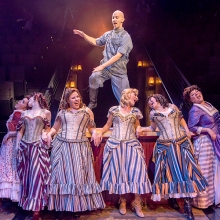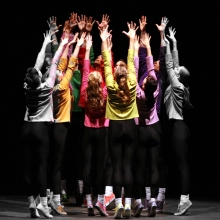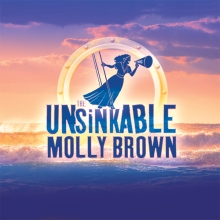Filichia Features: West Side Story Now and Then

Filichia Features: West Side Story Now and Then
Mark S. Hoebee’s current production of West Side Story at the Tony-winning Paper Mill Playhouse is getting both appreciative applause as well as stunned silences.
The applause comes from potent leads, excellent reproduction of Jerome Robbins’ choreography by Alex Sanchez and sharp pacing from Hoebee that makes each act seem to be only a few minutes long.
Of course the audience is also applauding the work itself. Although Stephen Sondheim wasn’t yet a blue-chipper in 1957 when he wrote his first set of lyrics for a Broadway musical, he did more than hold his own with West Side’s fine librettist Arthur Laurents and brilliant composer Leonard Bernstein.
Who knew then that Sondheim would eventually leapfrog over them in theatrical greatness? Notice that you can’t see Broadway shows at the Laurents Theatre or Bernstein Playhouse, but you can catch Beautiful at The Stephen Sondheim Theatre.
As much as we all admire the 1961 Oscar-winning film, the show works better on stage. So if you’ve been intimidated at the thought of producing and directing West Side Story because you’re afraid that your audience will say, “Well, it wasn’t as good as the movie,” let Hoebee’s production remind you that there are many ways that a stage production can pack an even greater punch than the film.
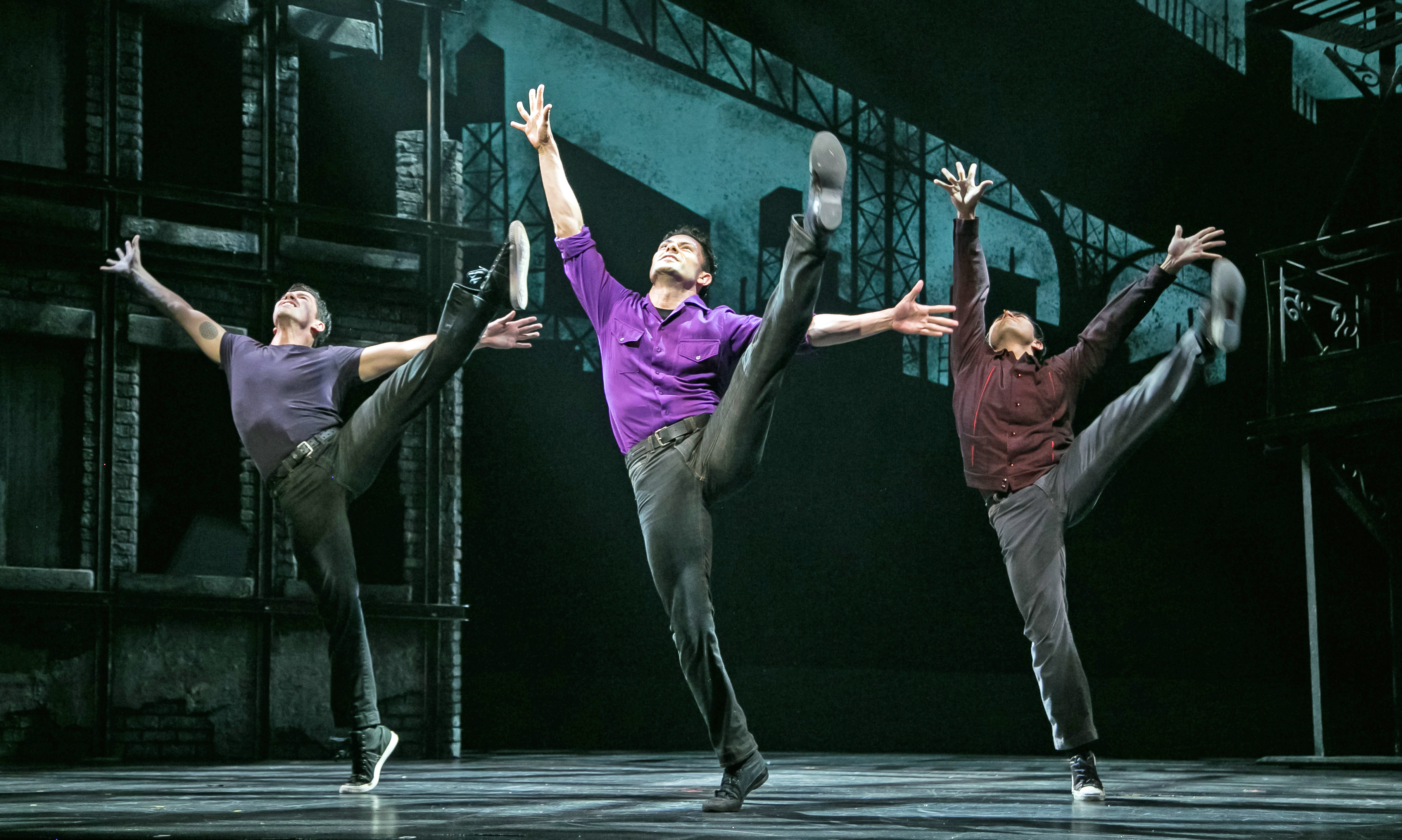
The Sharks in Paper Mill Playhouse's production of West Side Story (Photo by Jerry Dalia)
Although Manhattan is not even 14 miles long, it somehow looks spacious in the movie. Putting West Side Story in a contained space supports the statement “This turf is small” made by Riff, the leader of the so-called “American” Jets. His gang and the Puerto Rican Sharks, led by Bernardo, seem to be crowding each other all night long.
Have you an actor who can be a convincing Tony? This has always been the toughest role to cast. Tony is, after all, the co-founder of the Jets, and although he’s left the gang, he should retain some street-punk residue. Seldom do we see a Tony who shows any; that certainly includes the film’s Richard Beymer, whose sensitive looks suggest that he spent his childhood enduring many playground beatings.
Here Matt Doyle’s Tony wouldn’t scare anyone, but he’s tougher than most. His classical-Broadway pipes had to be the main reason that Hoebee chose him. When he sings “The most beautiful sound I’ve ever heard,” he’s of course crooning about Maria, but he could just as easily be referring to his own voice.
So keep in mind that your Tony must give out strong masculinity and an equally strong voice.
Love makes Belinda Allyn’s Maria grow and develop a substantial backbone. When Anita castigates her for loving the man who killed her brother, Allyn doesn’t merely sing “You should know better,” but virtually spits it out. This sudden-found ferocity serves Allyn well, for it better sets up the final scene in which Maria explodes at everyone and becomes a genuine madwoman.
You’d be well-served if your potential Marias could see Allyn. They’d also profit from seeing Paper Mill’s Chino – for different reasons.
Dean Andrea De Luna is Chino, the young man whom everyone wants Maria to marry -- except, of course, Maria herself. Jose de Vega played him namby-pamby in the film, but Hoebee makes Chino come across as strong. Now we begin to understand why Maria’s friends and family think he’s a good match for her. We never do in the film.
However, in the scene where Chino must tell Maria that her beau has killed her brother, De Luna doesn’t display much emotion. We expect to see his agony as he wonders how to deliver this gut-wrenching news. Here De Luna seems as if he’s about to tell Maria that her apartment has no hot water.
Crag Waletzko is Glad Hand, the only name given to the poor soul who runs the local dance and tries to get the two gangs to become friends. He starts off as silly as John Astin in the film, but creates a fuller-bodied character by having him become Hard Hand, eventually bursting into full-blown anger and not regretting it at all. Let the punishment fit the many crimes.
This is one scene where the audience sat in the stunned silence that I mentioned earlier. Glad Hand’s mission was to have everyone “form two circles, boys on the outside, girls on the inside” so that “when the music stops, each boy dances with whatever girl is opposite.” He plans to stop the music when a Jet is standing in front of a Puerto Rican girl and a Shark finds an “American” lass facing him. Glad Hand does just that, but no one plays by the rules he’d set. Bernardo grabs Anita and Riff seizes Velma.
But Hoebee has added a powerful moment that you should consider for your production. Velma (Summerisa Bell Stevens) takes one look at Bernardo and gives a look of repulsion that would be more apt for the mother who meets the drunk driver who’d killed her three children. Stevens’ glare and snicker remind us how the “Americans” believed themselves to be so superior to the Puerto-Ricans. And yet, when West Side Story debuted, Puerto Ricans had in fact been American citizens for more than 40 years. But try telling that to the Jets.
In the film, Simon Oakland’s Lieutenant Schrank seems merely annoyed at the constant strife between the gangs; here William Ragsdale shows that his Schrank moved away from frustration long ago. Now he’s ferocious and utterly obnoxious to both gangs, but with a decided hatred for the Sharks. (”What you Puerto Ricans have done to this neighborhood!”)
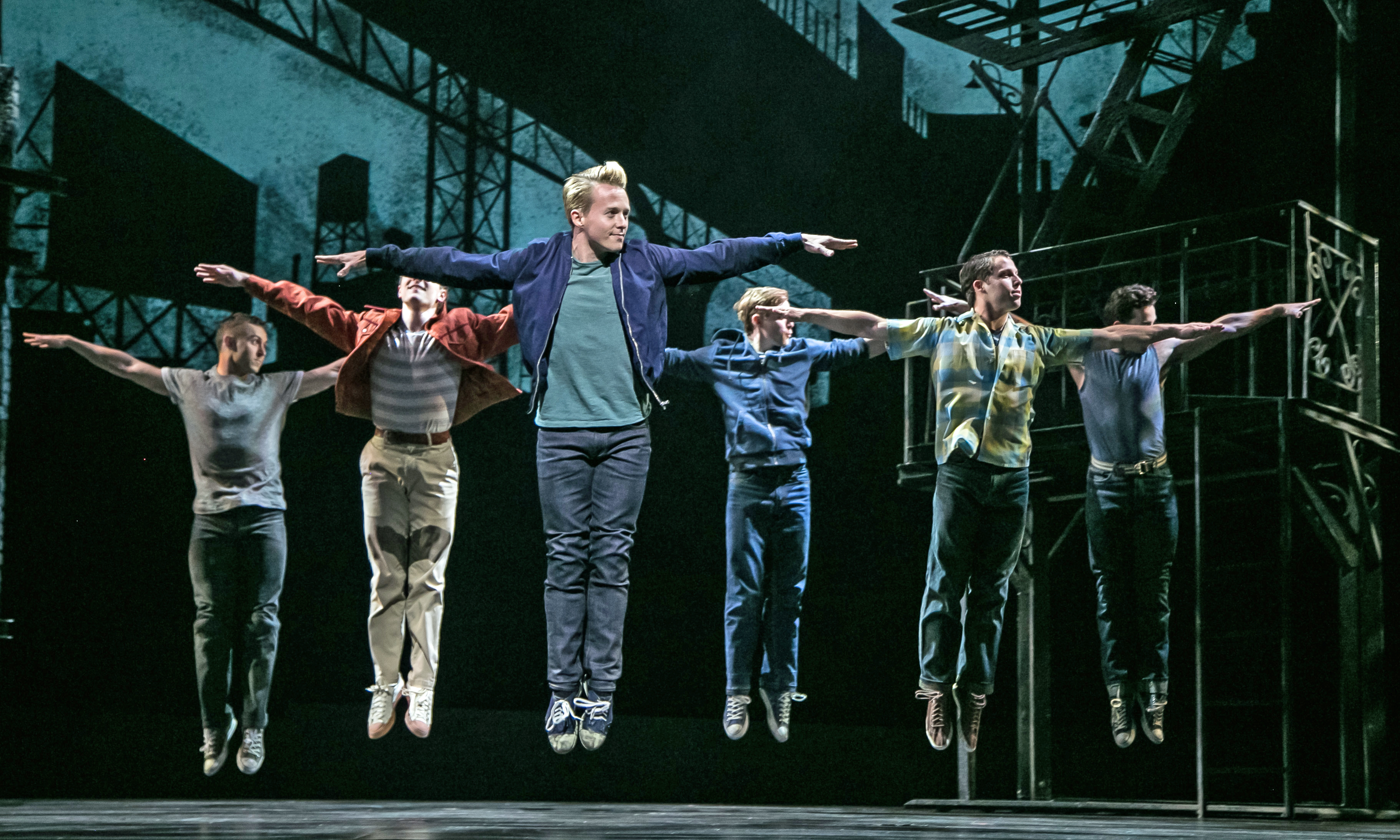
The Jets in Paper Mill Playhouse's production of West Side Story (Photo by Jerry Dalia)
So is West Side Story “dated” because the conflict between so-called Americans and Puerto-Ricans has lessened or even disappeared? In an age when Spanish has become our country’s unofficial second language, does it have anything left to teach us?
Yes. Sad to say, West Side Story has gone from a topical musical to a metaphorical one. Even if the grandchildren of the people the show portrayed are now living in peaceful coexistence, you don’t need me to tell you that plenty of individuals of other nationalities and religions have tremendous hatred for each other. Perhaps new productions of West Side Story can help change that.
Bernardo kills Riff, so Tony kills Bernardo, so Chino kills Tony. Three murders in one musical is potent stuff even now, but in 1957, it was unheard of. Take for example the shows that had won Best Musical Tonys to that point. Only one had even two deaths (The King and Lun Tha in The King and I) and only two others had even one (The Wazir in Kismet and Lieutenant Cable in South Pacific). But all those characters in other musicals lived longer than the two Jets and one Shark who die in the show. West Side Story remains the musical that above all others proves that two wrongs don’t make a right – and that’s why it’s always worth seeing, hearing and producing.
You may e-mail Peter at pfilichia@aol.com. Check out his weekly column each Monday at www.broadwayselect.com and Tuesday at www.masterworksbroadway.com. His book The Great Parade: Broadway’s Astonishing, Never-To-Be Forgotten 1963-1964 Season is now available at www.amazon.com.
Share
Callboard
-
Shake and shimmy it with the #Hairspray20Challenge! Join MTI and Broadway Media in celebrating 20 years of #Hairspray. Duet this here or find us on TikTok! Special thanks to @broadwaymedia and @jammyprod. Choreography Guides are a licensor official resource that provides step-by-step instruction from Broadway and professional choreographers for your productions! Visit @broadwaymedia to learn more. #mtishows #youcantstopthebeat #hairspraymusical #goodmorningbaltimore
View on Instagram





















